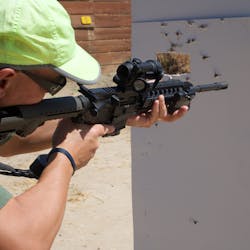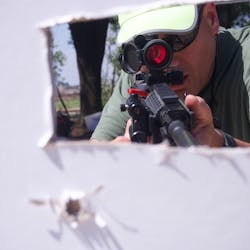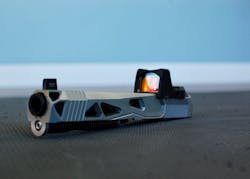Test & Eval Of Aimpoint PRO And Trijicon RMR
Red dot sights have quickly dominated the military and police market since their commercial introduction in 1975. The first successful commercial product was the Aimpoint Electronic, a result of engineers working closely with end users to design a product. Since then, it has become a revolution of tactical solutions.
Today, many law enforcement officers are using red dot sights in the field, primarily for fast target acquisition. Taking the perspective of a non-user, I tested the Aimpoint PRO and a Trijicon RMR mounted on an AlphaWolf slide by Lone Wolf Distributors—both products are enough to convince anyone to convert to optics.
What is a red dot optic?
Red dot optics superimpose a dot on the target. Where the dot goes, the bullet goes. If used correctly, they allow fast target acquisition and alignment. There are other shapes available, such as triangle shaped dots and full reticle images, but the overall concept is similar. Generally, we are talking about non-magnifying optics that place a dot on the target.
Some users were slow to adopt red dot optics. When military units began fielding the M68 CCO, basically an Aimpoint Comp M2, everyone started mowing down pop ups with Aimpoint-mounted M16s.
I was around when we fielded the M68. Soldiers liked them because they were basically NVG compatible. We were worried about the battery issue, since it took a power cell that one couldn’t buy in any drug store. Everyone was worried about parallax. It was parallax-free to about 50 meters. I knew this would never be an issue for a cartridge that flies pretty flat out to its usable range.
Yes, parallax exists on a red dot device. Parallax is the difference between the actual and apparent position of an object viewed through an optic. It happens on an optic because the dot is superimposed on a lens in the internal workings of the optic. If the angle of the point of view is changed, the apparent location of the object is changed. Optics manufacturers set parallax to coincide within the usable range of the product.
Some of the stories about military use were true. We really did have one user that turned it on as they started their deployment and turned it off when they were getting ready to return home. Some units survived pretty legendary falls and continued to function.
There are basically three reasons red dots really work for law enforcement. Officers can sight and shoot with both eyes open, opening up nearly the full periphery of vision when scanning. One can put almost anything in front of, and some things after, and still maintain compatibility. Taller accessories don’t block the sighting ability, allowing suppressors, large muzzle devices and back up sights in the sighting plane.
The strength of the Aimpoint PRO
The Aimpoint Patrol Rifle Optic (PRO) is an electronic red dot optic purpose-built for law enforcement use. It has a 2 minute of angle dot that’s good for a full three years on a single battery change. There are plenty of red dot sights on the market today, but I think Aimpoint has used their experience in military grade products to produce the PRO. When I say experience, I mean that Aimpoint kept the weight of the tool down and maintained the inherent ruggedness. They recessed the glass well into the case and threaded the front of the optic for an ARD.There are two other features that demonstrate Aimpoint’s military experience. First, all of the caps that can unscrew, including turret and battery covers, are tethered. There’s nothing like losing an essential component out in the middle of nowhere and having to change operational readiness because of the loss. This is one of the reasons why I do not recommend cheaper optics. Attention to detail is everything.
Second, Aimpoint uses the QRP2 Rail Grabber Mount. This comes from the experience of using a steel mount on an aluminum receiver. Troops are trained to tighten the torque mounting device and then snap it three times. It doesn’t require tools and finger tightening is perfect for the torque metering device. Rail deformation on an AR-15 can be permanent and will affect accuracy. The QRP2 Rail Grabber Mount almost eliminates it.
The thing I like best about the PRO Optic is the ease in which a magnifier can be mounted in front of it. The Aimpoint 3X Magnifier gives it even more flexibility, especially if one uses the LaRue QD Mount. With this mount, one can flip the magnifier out of the way, or detach it and stick it in a cargo pocket.
Why don’t we just use the military issued Aimpoint products? The Aimpoint PRO is purpose built for law enforcement and is within the price range of most end users.
A close look at the AlphaWolf slide and Trijicon RMR
I had Lone Wolf Distributors build me one of their new AlphaWolf slides, complete with a Trijicon RMR sight.
The RMR is a compact, durable, optic that can be used as the primary optic on handguns, rifles, carbines and shotguns. It has just begun to appear on duty slides. There are three versions of the compact set up. One uses both tritium and fiber optics to light the dot. Two other versions use a CR 2032 battery. Both are designed to allow the user to adjust the brightness of the dot, based on varying conditions.
When the RMR was first popular for pistols, some gunsmiths mounted it directly on top of the slide. Eventually users started recessing the RMR into this life. Now, it is common to purchase aftermarket slides (and some OEM products) with integrated RMR cuts.
Lone Wolf can customize a slide for the end user. The one I requested was a “slide melt” design, including the COMBAT position for the RMR. This puts the sights slightly in front of the RMR, allowing co-witnessing.
Co-witnessing is when the iron sights can be used in the window of the optic. This guarantees that the bullet steering device, which relies on power, doesn’t leave the shooter rudderless when the batteries fail or the glass breaks. Users generally install sights that take up the bottom third of the view of the optic, which keeps it out of the way when the dot is being used. If used correctly, the shooter can use iron or glass almost interchangeably.
The optic-mounted slide has several advantages. First, it’s easy to add a threaded barrel and not worry about sight height for most compact suppressors. Of all the things that optics give a shooter, this is a great advantage.
Mounting an optic also changes the balance of the gun, Lone Wolf Distributors know how to take advantage of this. The machined cut outs on this custom slide aren’t just decorative.
When I ran the AlphaWolf slide, it felt a little softer in the recoil department, but reset quicker. Side-by-side, I can put accurate fire down range faster with the AlphaWolf slide. Bear in mind, this slide has a LWD S/S Guide Rod Assembly and an AlphaWolf Barrel, which is on my other Glocks. The S/S Guide Rod is a must for high volume, high performance shooting.
Advantages and disadvantages of red dot optics
The advantage of red dot optics is being able to scan with both eyes. To increase speed and accuracy, one must train to focus on the target. Beginning shooters will let the sights lead them around. They see the target right up until the front sight comes into their periphery then focus on the front sight. The gun comes into the sighting plane and the shooter aligns it to the target.With red dot sights, shooters can maintain their target focus, then bring the sighting device into the visual plane. The focus on the target is unbroken. If the shooter does all other things correctly, the shot breaks and the target is correctly engaged. It’s faster. There are, however, some drawbacks.
First, I don’t like to rely on things connected to a battery, despite the fact that I am a technology early adopter. Second, some users believe that using an optic means that one does not need to use other shooting essentials like getting a good cheek weld on the carbine or a master grip on the handgun. Third, some of us are frustrated by a dancing dot, whereas the alignment of iron is quite natural.
Finally, there is the issue of offset. While it’s not that evident on a handgun, most optics are mounted high on a carbine. Past point blank, this really isn’t an issue. Looking over a barricade, or through a slit port on a barricade will quickly reveal the problem. The bullet goes out of the launcher lower than the perception of the shooter when an optic is used.
Offset becomes even more pronounced when the optic is mounted higher. Leupold has several mounting options for their 6x20mm D-EVO (Dual-Enhanced View Optic). This tiny scope has a mounting platform for a red dot, and I recommend the Leupold Carbine Optic (LCO).
Next time you’re visiting a range that has a practice vehicle, look at the hood of that vehicle. If it has gouges, burn marks or even bullet holes in the hood, someone has been shooting a carbine with an optic. Here’s a tip for the agency firearm instructor—never use an in-service vehicle for range training practice. The memo about the hood is a hard one to explain.
While red dot optics can definitely improve an officer’s overall shooting scores, they are not a cure-all for poor marksmanship or poor technique. Even though the newest products are pretty tiny, they still don’t fit all the way into a duty holster. There are plenty of great holster products that have relief cuts for optics. Expect to see more red dots on patrol in your future.

Officer Lindsey Bertomen (ret.), Contributing Editor
Lindsey Bertomen is a retired police officer and retired military small arms trainer. He teaches criminal justice at Hartnell College in Salinas, California, where serves as a POST administrator and firearms instructor. He also teaches civilian firearms classes, enjoys fly fishing, martial arts, and mountain biking. His articles have appeared in print and online for over two decades.






